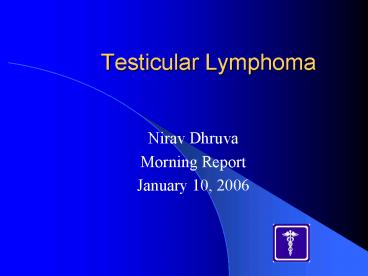Testicular Lymphoma - PowerPoint PPT Presentation
1 / 17
Title:
Testicular Lymphoma
Description:
NHL was responsible for 19,200 deaths in US last year and 56,390 cases were ... of tx was xrt for local and regional spread and chemo for distant metastasis ... – PowerPoint PPT presentation
Number of Views:513
Avg rating:3.0/5.0
Title: Testicular Lymphoma
1
Testicular Lymphoma
- Nirav Dhruva
- Morning Report
- January 10, 2006
2
Background
- NHL was responsible for 19,200 deaths in US last
year and 56,390 cases were diagnosed in 2005 - NHL of the testicle is a rare extranodal
presentation of NHL as it represents only about
1 of all lymphomas - It accounts for 5 of all testicular neoplasms
3
Background
- Most are of intermediate or high grade according
to Working Formulation or Diffuse Large B-cell
lymphoma in the REAL classification. 52/64 cases
reported by Ferry et al. were diffuse large cell
lymphoma. Some estimate 80-90. - Usually occurs in age gt 60, most frequent
testicular neoplasm in this age group
4
Presentation
- Can occur in only the affected testicle, but
extranodal presentation is very common. - Common extranodal sites are the contralateral
testicle, CNS, skin, and Waldeyer ring
5
Disease Course
- Testicular lymphomas have a high rate of
recurrence and act aggressively. The ability and
propensity to disseminate to extranodal areas
makes testicular lymphoma unique from its nodal
cousins. ? Of expression of CD44/other adhesion
molecules to facilitate dissemination.
6
Disease Course
- Mayo Retrospective Study 62 patients with
testicular lymphoma. Median age 62. 88
patients had no residual disease after primary
tx, 80 had recurrence. Treatment did not affect
recurrence rate. Median f/u of 2.7 years 60
died. 13 patients had CNS recurrence (11
parenchymal) 8 patients had recurrence at CL
testicle. 79 had localized or regional disease
at presentation. Systemic symptoms 5 at
presentation. Patients who had a CR, DFS could
not be predicted based on stage, age, bm, or type
of tx
7
Outcome and Prognostic Factors in Primary Large
Cell Lymphoma of Testes (International Extranodal
Lymphoma Study Group)
- Retrospective survey. 373 patients. Median age
66yrs. Most present with local dx.
Anthracycline chemo 68, prophylactic intrathecal
chemo 18. Median survival 4.8 yrs. Favorable
IPI, no B sx, use of anthracycline, and prophyl
scrotal xrt assoc with longer survival at
multivariate analysis. Failures usually occur
within 1-3 years. In this study, even localized
disease benefited from anthracycline chemo
(longer PFS and OS). More CNS failures in
parenchyma.
8
Treatment
- Orchiectomy is the initial primary therapeutic
and diagnostic intervention. - Systemic Chemotherapy in the past, the standard
of tx was xrt for local and regional spread and
chemo for distant metastasis - However, given the poor prognosis of even stage
I/II disease, combined modality including
chemotherapy has become more frequent as initial
therapy. Several studies indicate anthracycline
containing regimen is favorable smaller ones
exist showing no effect.
9
Treatment
- Prophylactic Irradiation of Contralateral
Testicle - people feel it is a reservoir for
extranodal disease because of the blood/testes
barrier. - In the Mayo study, no one who underwent
contralateral xrt had recurrence at that site
initially, but one case at 120 months after. - Low complication risk reasonable to consider,
especially in elder men.
10
Intrathecal Chemotherapy
- Tendency to relapse in CNS (? Blood / brain
barrier) - Many argue for CNS prophylaxis with intrathecal
agents - Used for patients with meningeal involvement
- Mayo study had high rate of parenchymal
recurrence ???
11
NK/T cell
- NK cells are CD 56 cytotoxic/cytolytic cells
usually expressing one or more of NK assoc
antigens (CD 11b, CD 16, CD 56, and CD 57) - Cells usually are CD2, CD56, surface CD 3- and
cyctoplasmic CD3. Most express cytotoxic
granule proteins, such as granzyme-B and TIA-1.
Lack surface TCR. Share features with T cell
(CD2, CD 7, CD3e, CD43). - Usually can distinguish NK cell from T cell by
lack of surface CD3 and lack of TCR gene
arrangements
12
NK/Tcell
- Usually in upper aerodigestive tract possible
act as first line of defense - Very rare type approximately literature
affecting testicle 9-10 cases reported (at the
most)
13
NK/Tcell
- Appears to be more common in Asian, Mexican, or
South American descent - Strongly associated with EBV virus
- Usually extranodal presentation with angiocentric
growth and large granular lymphocyte morphology - Genetics loss of heterozygosity at 6q occurs at
high frequency
14
NK/Tcell
- B symptoms are usually uncommon
- Poor prognosis 4 patients described in
literature with testicular involvement died
within 6 months of diagnosis
15
NK/Tcell
- Neoplastic cells surrounding and infiltrating
vessel wall
16
Conclusion
- Testicular lymphoma has a low incidence rate with
a high rate of recurrence. - More information is needed in order to manage
these patients but the low incidence rate makes
prospective trials quite difficult
17
References
- Sasai K, Yamabe H et al. Primary Testicular
Non-Hodgkins Lymphoma A Clinical Study and
Review of the Literature. Am J Clin Oncol,
Volume 20 (1). February 1997. 59-62 - Ballereau Charles, Leroy X, et al. Testicular
natural killer T-cell lymphoma. International
Journal of Urology (2005). 12, 223-224. - Up to Date. Clinical and pathological features
of mature peripheral T and NK cell lymphomas. - Totonchi K, Engel G, et al. Testicular Natural
Killer/T Cell Lymphoma, Nasal Type, of True
Natural Killer-Cell Origin. Arch Pathol Lab Med.
Vol 126. December 2002. - Fonseca R, Habermann T, et al. Testicular
Lymphoma is Associated with a High Incidence of
Extranodal Recurrance. Cancer. Vol 88 1. Jan
2000. - Zucca E, Conconi A, et al. Patterns of Outcome
and Prognostic Factors in Primary Large-Cell
Lymphoma of the Testis in a Survey by the
International Extranodal Lymphoma Study Group.
Journal of Clinical Oncology Vol 21, January
2003. P 20-27. - Hasselblom S, Ridell B, et al. Testicular
Lymphoma. Acta Oncologica. Vol 43. P 758-765,
2004.































